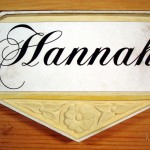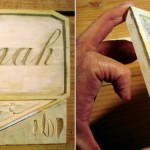Some of the best things I’ve learned, whether in my computer geek career, building boats, or other activities, have been those lessons learned from making mistakes. In fact, I believe that becoming a “Master” in anything means accumulating more know-how about fixing mistakes than the basic know-how related to the skill, craft, trade, or profession. The master woodcarver isn’t the one who knows how to carve a beautiful Newport Shell, but the one who knows how to avoid the mistakes in carving that shell.
 Simple carving patterns can be drawn directly onto the carving stock. For more complex patterns, or those requiring some degree of precision, I prefer attaching a paper pattern directly to the material. Transferring by carbon paper (they still make that stuff!?) or some similar method is tedious and error prone. Normally, rubber cement is my preferred bonding agent. Patterns are easy to reproduce on the computer, and to print when needed. I attach one to a block of wood and cut through it. When it is no longer needed, the remnants are easily peeled off and the cement residue rubbed away.
Simple carving patterns can be drawn directly onto the carving stock. For more complex patterns, or those requiring some degree of precision, I prefer attaching a paper pattern directly to the material. Transferring by carbon paper (they still make that stuff!?) or some similar method is tedious and error prone. Normally, rubber cement is my preferred bonding agent. Patterns are easy to reproduce on the computer, and to print when needed. I attach one to a block of wood and cut through it. When it is no longer needed, the remnants are easily peeled off and the cement residue rubbed away.
At the start of the recent carving projects, my can of rubber cement was empty. I tried a couple of substitutes. A pattern was attached to one block with liquid hide glue, and to another with yellow glue.
 BIG MISTAKE! Both glues led to the same problem. Moisture dissolved ink from the patterns, letting it wick into the carving’s surface. OUCH! It was OK on the Markus carving because the top surface of all the fish was carved away anyway, and the tops of the letters could be sanded clean (hate sanding!). It was disastrous with the Hannah carving (yellow glue), leaving a dark smear across the finished surface, with leaching too deep to sand away. The problem was discovered after the last step of that carving, the lettering. So, it needed a complete “do over.” The Georg pattern has a lot of ink in it, and not too far into that carving, I removed the pattern by (erroneously) softening the hide glue with water. ARRGH!
BIG MISTAKE! Both glues led to the same problem. Moisture dissolved ink from the patterns, letting it wick into the carving’s surface. OUCH! It was OK on the Markus carving because the top surface of all the fish was carved away anyway, and the tops of the letters could be sanded clean (hate sanding!). It was disastrous with the Hannah carving (yellow glue), leaving a dark smear across the finished surface, with leaching too deep to sand away. The problem was discovered after the last step of that carving, the lettering. So, it needed a complete “do over.” The Georg pattern has a lot of ink in it, and not too far into that carving, I removed the pattern by (erroneously) softening the hide glue with water. ARRGH!
Lesson: For patterns that are to be bonded to the carving material, test to see if the bonding agents (or removal agents) will leave undesirable stains. I have a new can of rubber cement. … and am now a slightly wiser carver.
Your discussion of mistakes reminded me of a quote, I had to look it up to make sure I got it right. It was quoted in Popular Woodworking Magazine #184, pg. 12.
“I am glad that I paid so little attention to good advice, had I abided by it I might have been saved from some of my most valuable mistakes.” Edna St. Vincent Millay
I think you got it right, that the master knows more about fixing mistakes than anything else. We all make mistakes, no one is perfect, it’s how we handle them that makes the difference.
Thanks Dave. Let’s keep on makin’ mistakes and learnin’. Maybe someday we’ll master something. 🙂